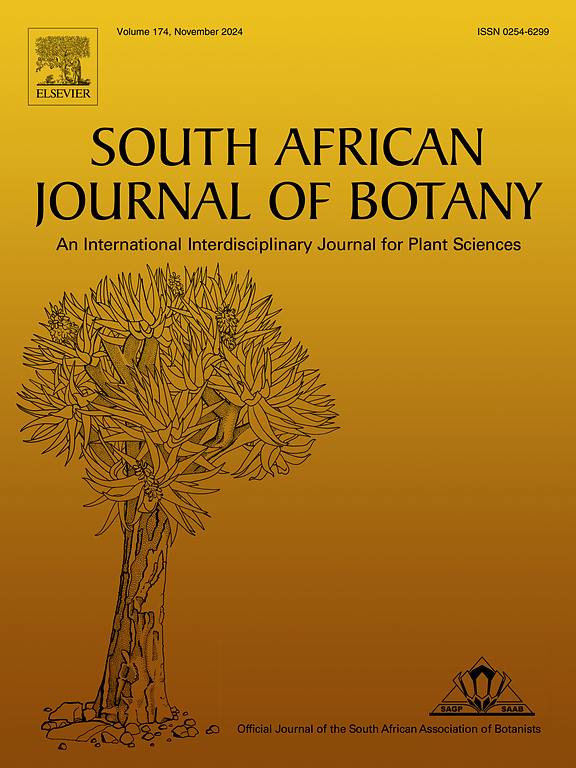In vitro propagation, physiochemical evaluation, secondary metabolites analysis and genetic fidelity assessment through SCoT marker in regenerated plantlets of Vernonia amygdalina Delile
IF 2.7
3区 生物学
Q2 PLANT SCIENCES
引用次数: 0
Abstract
Vernonia amygdalina Delile. is a small tree familiar for its potential medicinal values and widely used in containing 5.0 μM 6-benzylaminopurine (BAP). The highest shoot proliferation (24.00 ± 0.05 shoots/nodal segment) with average shoot length (6.86 ± 0.10 cm) was accomplished on MS + 5.0 μM BAP + 0.5 μM α-naphthalene acetic acid (NAA). Subsequent to in vitro regeneration, traditional medicine within the genus Vernonia. The present study focuses to standardize the micropropagation protocol of V. amygdalina using young nodal segment explants. The ideal medium for shoot initiation was determined to be Murashige and Skoog (MS) medium microshoots were successfully rooted on ½ MS + 1.0 µM indole-3-butyric acid (IBA). Acclimatization of rooted plantlets in Soilrite™ resulted in a 95 % survival rate upon transfer to the greenhouse. Start codon targeted (SCoT) primer-based molecular analysis was done to corroborate the genetic compatibility of regenerated plantlets. During acclimatization, gradual change in net photosynthetic rate, chlorophyll content, stomatal conductance, and transpiration rate was investigated. Additionally, changes in antioxidant enzyme activities, including superoxide dismutase (SOD), catalase (CAT), ascorbate peroxidase (APX), and glutathione reductase (GR), were also screened. The plantlets' healthy adaptation to their surroundings was also demonstrated by the leaves' scanning electron microscope (SEM) analysis. Furthermore, Gas Chromatography and Mass Spectrometry analysis (GC–MS) was used to compare the secondary metabolites profile from the mother and regenerated plantlets.
苦杏仁再生植株的体外繁殖、理化评价、次生代谢物分析及SCoT标记遗传保真度评价
苦杏仁。是一种具有潜在药用价值的小树,广泛用于含有5.0 μM 6-苄基氨基嘌呤(BAP)。在MS + 5.0 μM BAP + 0.5 μM α-萘乙酸(NAA)条件下,芽增殖率最高(24.00±0.05个芽/节段),平均芽长为6.86±0.10 cm。随后体外再生,传统医学属内的Vernonia。本研究的重点是规范扁桃幼节段外植体的微繁方案。最理想的生根培养基为Murashige和Skoog (MS)培养基,在½MS + 1.0µM吲哚-3-丁酸(IBA)培养基上生根成功。生根植株在Soilrite™中驯化后,转移到温室后成活率达到95%。利用起始密码子靶向(SCoT)引物对再生植株进行了遗传相容性分析。在驯化过程中,研究了净光合速率、叶绿素含量、气孔导度和蒸腾速率的逐渐变化。此外,还筛选了抗氧化酶活性的变化,包括超氧化物歧化酶(SOD)、过氧化氢酶(CAT)、抗坏血酸过氧化物酶(APX)和谷胱甘肽还原酶(GR)。叶片的扫描电镜(SEM)分析也证明了植株对环境的健康适应。此外,采用气相色谱和质谱分析(GC-MS)比较了母植株和再生植株的次生代谢物谱。
本文章由计算机程序翻译,如有差异,请以英文原文为准。
求助全文
约1分钟内获得全文
求助全文
来源期刊

South African Journal of Botany
生物-植物科学
CiteScore
5.20
自引率
9.70%
发文量
709
审稿时长
61 days
期刊介绍:
The South African Journal of Botany publishes original papers that deal with the classification, biodiversity, morphology, physiology, molecular biology, ecology, biotechnology, ethnobotany and other botanically related aspects of species that are of importance to southern Africa. Manuscripts dealing with significant new findings on other species of the world and general botanical principles will also be considered and are encouraged.
 求助内容:
求助内容: 应助结果提醒方式:
应助结果提醒方式:


